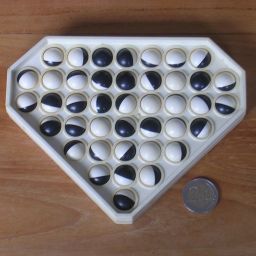

It's useful to note that whenever a single peg is jumped, it's known as a Single Jump. The peg that was jumped is removed from the board, leaving an empty peg-hole where it once was. We see that the peg we'll pick up and use to jump (with the arrow coming out of it) should hop over the peg directly to its right and take up a new home in the previously vacant center square to kick off the game.

Move #1 is very simple and involves only one jump.

To unravel the seemingly complex peg solitaire board, we'll work in two move groupings until we completely solve the game (in the least amount of moves to boot). Even though there were multiple jumps, as long as they were consecutive jumps (all in a row, jumped with the same peg) they still only count as one total move. Simply jump the original peg over each successive peg as shown in the graphic until you've reached the destination peg-hole.

As previously stated these will be indicated with multiple arrows on the same graphic. Occasionally, there will be multiple jumps during the same move. Throughout the guide, I'll discuss the direction of jumps based on whether or not they're moving toward the Left or Right sides of the board, and also if they are migrating Up (towards the top of the board) or Down (towards the bottom of the board). To aide in the memorization of this optimal Peg solitaire solution, we've listed each of the 18 maneuvers in two-move groupings (left to right in each category) along with headlines that note the move counts and a helpful title for each set of moves. After a few practice games with your own Peg solitaire board, you should have the hang of it in no time at all. In some cases, there will be multiple arrows in the same move indicating that multiple legal jumps are to be performed to execute the move correctly. The arrows will lead out from the peg that will be doing the jumping, known as the Target Peg (colored blue in our graphics), and will end at the indicated square following the initial jump. In the Peg solitaire solution below, we'll be using arrows to illustrate which peg should be used and in which direction it should be jumping other pegs for each move. Actually, these multiple jumps with the same peg actually only count as one total move, even though it jumped and removed multiple pegs from the board in the same sequence. However, a player can make multiple jumps with the same starting peg (without putting it down and selecting another) during the same turn as long as they are still following the standard rules above. Diagonal jumps are not allowed, and there must always be an empty target hole on the other side of the peg being jumped in order for the move to be legal (they can't jump over one peg and land on another). Pegs can only jump over pegs that are horizontally or vertically adjacent to the jumping peg, and can only jump over one peg at a time. Whenever a peg is jumped, it is removed from the board and is out of play.
PEG SOLITAIRE INSTRUCTIONS HOW TO
How to Play Peg SolitaireĪ player selects a peg and then moves it across the board by legally jumping any other peg that it chooses. To begin, let's take a quick refresher course on how a game of Peg Solitaire is played. The Chess and Poker Dot Com Peg Solitaire guide follows this solution with a clear, graphical explanation below. In fact, a man named Ernest Bergholt actually provided a solution to Peg Solitaire back in 1912 that required only 18 moves to sweep the board of pegs except for a lone fellow landing beautifully in the center hole on the final move of the game. However, many players worked very hard over the more than 300 years that the game has been played to discover a solution to the challenging puzzle, manually hashing out the moves by hand until they could successfully map out the proper configurations. If you've ever tried your hand at solving a Peg Solitaire board, you'll surely understand how frustratingly elusive these simple tasks turn out to be. The object of the game is to not only remove all of the pegs from the board by jumping over them with any of the other pegs, but also to accomplish this daunting task while simultaneously ending your jumping spree with a peg resting exactly in the center hole of the board. With easy-to-learn rules and seemingly simple goals, many are taken by surprise when they discover how deceivingly difficult the puzzle turns out to be. Peg Solitaire is one of the most recognizable and popular board games of all time. How to Solve Peg Solitaire (Hi-Q) with Step-by-Step Advice


 0 kommentar(er)
0 kommentar(er)
